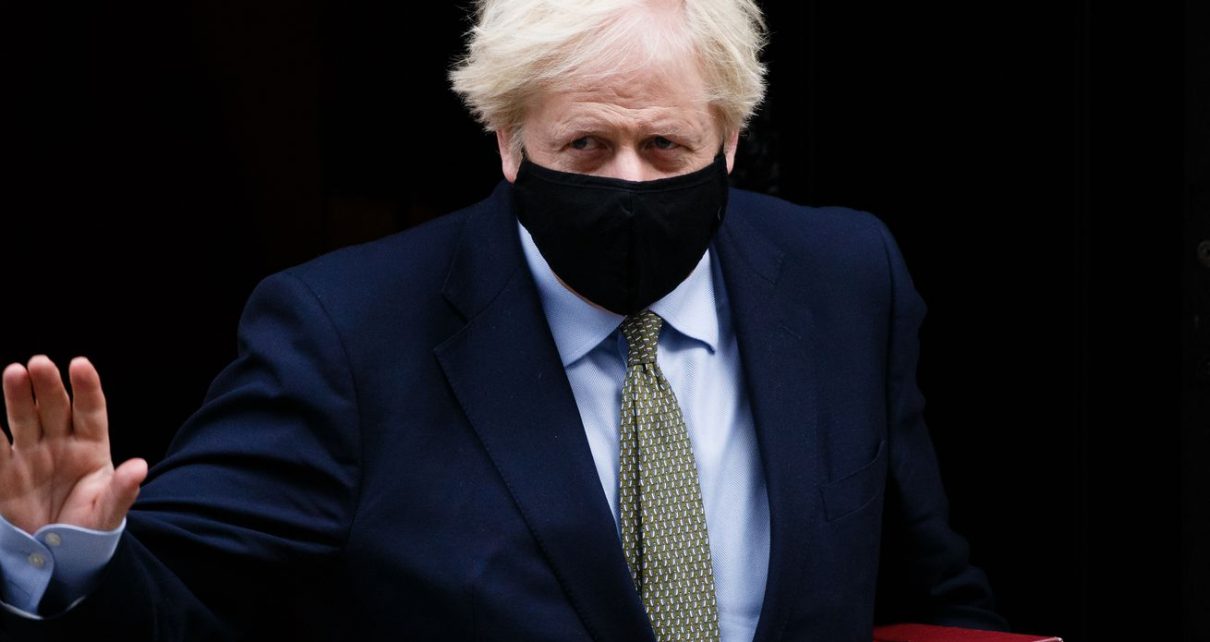 British Prime Minister Boris Johnson leaves 10 Downing Street wearing a face mask on his way to Prime Minister’s Questions (PMQs) at the House of Commons in London, England, on October 14, 2020. | Photo by David Cliff/NurPhoto via Getty Images
British Prime Minister Boris Johnson leaves 10 Downing Street wearing a face mask on his way to Prime Minister’s Questions (PMQs) at the House of Commons in London, England, on October 14, 2020. | Photo by David Cliff/NurPhoto via Getty Images
British Prime Minister Boris Johnson said the UK needs to prepare for no deal — but talks are probably not done yet.
Another Brexit deadline has come and gone. Well, sort of.
British Prime Minister Boris Johnson had set October 15 as the date for the United Kingdom to reach a trade agreement with the European Union. That self-imposed deadline arrived on Thursday, with both sides still at an impasse over their future relationship.
The October 15 deadline coincided with an EU summit in Brussels, where European leaders said they wanted to continue working toward a deal, but asked the UK to ”make the necessary moves to make an agreement possible.” Member states also acknowledged they should step up preparations for the possibility that no agreement will be reached ahead of the actual deadline, which is the end of the year.
Johnson responded on Friday by accusing the EU of being stubborn, saying it has “refused to negotiate seriously for much of the last few months.” Because of that, he said, the UK would also, with “high hearts and complete confidence,” prepare for a no-deal scenario.
“And we can do it, because we always knew that there would be change on January 1 whatever type of relationship we had,” Johnson said. “And so now is the time for our businesses to get ready, and for hauliers to get ready, and for travellers to get ready.”
Johnson, however, did not explicitly walk away from the talks — and negotiations are expected to continue in some form. Which is pretty much what a lot of observers expected: more tough talk, but no real drastic action on either side.
But even if Brexit talks are not totally dead, they’re definitely entering a much more precarious phase.
There has been progress in some areas, but both sides remain mired on the major sticking points. The UK’s attempts to try to renege on parts of the original Brexit deal, and the EU’s decision to take them to court over it, has also complicated matters.
And, again, there is a very real and very fixed deadline of December 31 that is getting uncomfortably close. Unlike the first phase of Brexit, this end date can’t be easily delayed.
So both sides really do need to prepare for a future without a deal.
How the EU and UK got here, which feels like a place they’ve been before
The United Kingdom formally left the European Union in January 2020, but it continued to follow the rules of the EU under the terms of the Brexit deal, which allowed for a transition period until the end of 2020.
The point of the transition period was to give both the EU and the UK time to figure out their post-breakup relationship. The two sides need to come up with a trade arrangement, but they also have to deal with a slew of other issues, from fishing to security cooperation.
Those negotiations have not been going well at all, and both sides are at odds on key issues, specifically state aid and fisheries. The latter is as much a symbolic issue for the UK as an economic one, but the state aid — or so-called “level playing field” — is really the crux of the problem.
The EU is insisting that if the UK wants tariff-free access to its single market, it can’t try to undercut the EU by subsidizing industries or businesses, or by lowering standards on things like environmental or labor protections that might give British businesses a boost.
But for the UK, which wanted to Brexit so it could be a rulemaker instead of a rule-taker, adhering to EU standards is the opposite of what Brexit was supposed to deliver as the UK reestablished its own trading regime.
The UK says this can be solved by a regular, old-school-style free trade agreement, like the one Canada has with the EU. But the EU says the UK isn’t Canada, not in terms of proximity and access — plus they cooperate on so many other fronts — so that deal can’t be replicated.
And back and forth it’s been going for months.
The Covid-19 pandemic has also complicated talks, consuming much of the energy in London and other EU capitals earlier this year and forcing negotiators onto videoconferences, where those side discussions that often lead to breakthroughs can’t happen. (Plus, diplomats on both sides got Covid-19.) The two sides have tried to rejuvenate discussions and create target deadlines, including this month, but it didn’t generate all that much progress.
Because everything wasn’t already difficult enough, in September, Johnson’s government introduced legislation called the Internal Market Bill, which would tweak some elements of the withdrawal agreement — a.k.a. the OG Brexit bill — related to Northern Ireland.
Opponents say this breaks international law; the EU has said the same and is mounting a legal challenge over the potential violations. Some experts saw Johnson’s play as “macho brinkmanship” aimed at forcing the EU to budge in the larger negotiations, but the EU has held firm.
And so the two sides got to mid-October with no big movement on the major issues and both sides blaming the other of being uncompromising on their red lines.
At the EU summit this week, European leaders — who’ve continued to display a lot of unity — said they wanted to continue talks, but also said the UK needed to rethink its positions. The UK responded, of course, by saying that, based on the EU summit, Brussels wasn’t willing to give the UK a trade deal that it wanted, and it was prepared to walk away.
But neither side has actually done that, at least not yet. European Commission President Ursula von der Leyen said Friday that “the EU continues to work for a deal, but not at any price.” She said the EU team would still go to London to continue talks next week.
– talks: the EU continues to work for a deal, but not at any price.
As planned, our negotiation team will go to London next week to intensify these negotiations.
— Ursula von der Leyen (@vonderleyen) October 16, 2020
The top Brexit negotiators — for the EU, Michel Barnier, and for the UK, David Frost — said they would talk early next week, though Frost told Barnier not to come to London unless the EU has a new plan, according to the Guardian. European leaders have also urged Johnson to keep talking.
This mid-October deadline was largely made up, but time really is running short. Barnier has previously said that any agreement needs to be reached by the end of October, so that the European Parliament has time to review and approve this brand new relationship. This is probably a flexible deadline, too, but the deeper talks go into November or December, the more challenging it will be to implement new arrangements by the end of the year.
And though it might feel like we’ve seen this Brexit show before — down-to-the-wire talks with looming deadlines — things really are different this time.
Why the threat of a no-deal Brexit still remains
Unlike the first phase of Brexit, where the deadline kept getting delayed and delayed and delayed, that possibility is a little less likely here. The current December 2020 cutoff is written into the Brexit deal between the UK and EU, which is now an international treaty. The UK could have extended it but had to make that choice by the end of June, and it declined to do so.
And while the possibility of a last-minute fudge can’t entirely be ruled out, that only seems likely if there’s real movement on the major issues in this future relationship. Which is why both sides have brought up, again, that they’re preparing for the possibility of a no-deal.
All the catastrophically disruptive things that could have happened if the UK left the EU without a plan in place before Brexit could still occur if the two sides reach the end of the transition period without agreements in place.
That’s because once the transition period expires, all the trade and regulatory arrangements the UK was following will end. The two sides will trade under World Trade Organization rules, which sets the tariffs and quotas between countries that don’t have free trade agreements in place with each other.
Johnson has taken to calling this an “Australia-style” deal “based on simple principles of global free trade.” Australia does not have a formal free trade agreement with the EU, but it does have a slew of cooperative agreements — which the UK wouldn’t have if it left on January 1 without a deal. Plus, the UK’s trading relationship with the EU far outstrips whatever Australia’s is. So, as some have pointed out, it would actually be more of an “Afghanistan-style” deal or a “Somalia-style” deal or, well, you get the point. It’s nothing.
Which means checks and controls could create massive, disruptive gridlocks at ports of entry. Companies and businesses will face new rules and barriers to trade. It could be a painful adjustment for the EU, but it will be far more damaging to the UK.
In general, a 2020 no-deal could still look a lot like the one experts predicted before Brexit became official — except, of course, businesses are already struggling because of pandemic restrictions, making it harder for them to prepare for the uncertainty. One firm estimated a no-deal Brexit plus Covid-19 could cost the UK economy $174 billion per year, over a decade.
The pandemic-caused economic crisis may give Johnson some political cover to end Brexit talks without a deal — essentially, he can file all economic disruption under the category of Covid-19, rather than Brexit, and hope nobody notices.
But that may not fly, as businesses are already saying they’re not prepared for a no-deal amid the pandemic, and the rest of the UK is starting to wake up to the realities of Brexit, including all this new infrastructure going up to prepare for potential post-Brexit border checks.
Both the UK and the EU want to avoid this no-deal scenario, but as more and more self-imposed deadlines pass, the real one is getting closer — without any clear sign of compromise.
Millions turn to Vox each month to understand what’s happening in the news, from the coronavirus crisis to a racial reckoning to what is, quite possibly, the most consequential presidential election of our lifetimes. Our mission has never been more vital than it is in this moment: to empower you through understanding. But our distinctive brand of explanatory journalism takes resources. Even when the economy and the news advertising market recovers, your support will be a critical part of sustaining our resource-intensive work. If you have already contributed, thank you. If you haven’t, please consider helping everyone make sense of an increasingly chaotic world: Contribute today from as little as $3.




